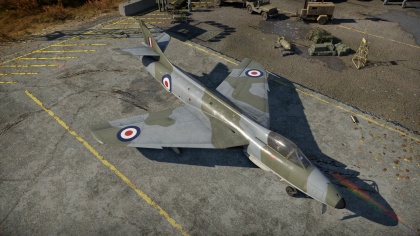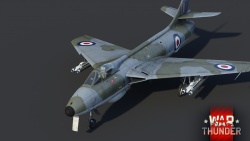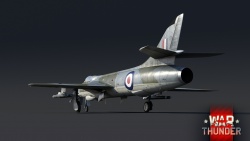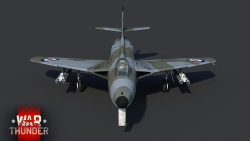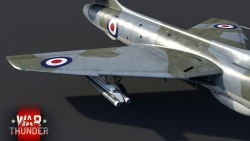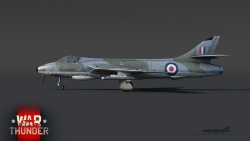Difference between revisions of "Hunter F.6"
(→Pros and cons: Edits) |
(→Counterplay: Decreased heading level) |
||
| Line 148: | Line 148: | ||
The aircraft does have a rangefinding [[Airborne radars|radar]], but it is near useless except in [[:Category:Game modes#Simulator Battles|simulator battles]]. | The aircraft does have a rangefinding [[Airborne radars|radar]], but it is near useless except in [[:Category:Game modes#Simulator Battles|simulator battles]]. | ||
| − | == Counterplay == | + | === Counterplay === |
This aircraft is an extremely potent aircraft at its tier, but it has its weaknesses. For one, it does not turn very well, most supersonics and nearly all subsonic aircraft can outturn it. Secondly, it has good energy retention, so even supersonics may find it hard to disengage from a turning engagement. To attack this aircraft, come in from behind it, and preferably from the top or bottom. Do not attack from the front, as the quad 30mm cannons will make short work of anything in their path. If your initial attack is unsuccessful, do not attempt to extend out in front of the Hunter; rather go into the vertical, as you will get caught by an SRAAM if you extend horizontal. If you suspect that a Hunter is nearby, do not allow your speed to drop below 800-1000 km/h, as anything below these speeds will allow the Hunter to catch and kill you. | This aircraft is an extremely potent aircraft at its tier, but it has its weaknesses. For one, it does not turn very well, most supersonics and nearly all subsonic aircraft can outturn it. Secondly, it has good energy retention, so even supersonics may find it hard to disengage from a turning engagement. To attack this aircraft, come in from behind it, and preferably from the top or bottom. Do not attack from the front, as the quad 30mm cannons will make short work of anything in their path. If your initial attack is unsuccessful, do not attempt to extend out in front of the Hunter; rather go into the vertical, as you will get caught by an SRAAM if you extend horizontal. If you suspect that a Hunter is nearby, do not allow your speed to drop below 800-1000 km/h, as anything below these speeds will allow the Hunter to catch and kill you. | ||
Revision as of 13:27, 17 July 2020
Contents
| This page is about the British jet fighter Hunter F.6. For the other version, see Hunter (Family). |
Description
The Hunter F.6 is a rank VI British jet fighter
with a battle rating of 10.0 (AB) and 9.7 (RB/SB). It was introduced in Update 1.89 "Imperial Navy".
General info
Flight performance
As with many early jet aircraft, the Hunter is slow and ungainly on takeoff and landing and is quite lethargic while flying at slow speeds. However, once this fighter begins to accelerate, it can hit speeds exceeding 800 kph and similar to the early French Mystère fighters, can only achieve supersonic speeds during a dive. While a clumsy aircraft at low speeds, it is a rather good turning aircraft at higher speeds, though still surpassed by some sub and supersonic aircraft. It can hold a 9-10 G turn without risking breaking its wings, however, anything above this and you risk shearing off a wing. This fighter has extremely good energy retention, far above any supersonic and above many subsonic aircraft, which can be used to its advantage to maintain a controlling position on the battlefield.
| Characteristics | Max Speed (km/h at 0 m - sea level) |
Max altitude (metres) |
Turn time (seconds) |
Rate of climb (metres/second) |
Take-off run (metres) | |||
|---|---|---|---|---|---|---|---|---|
| AB | RB | AB | RB | AB | RB | |||
| Stock | 1,138 | 1,132 | 15500 | 25.8 | 27.2 | 56.1 | 50.0 | 820 |
| Upgraded | 1,159 | 1,148 | 24.5 | 25.0 | 86.0 | 70.0 | ||
Details
| Features | |||||
|---|---|---|---|---|---|
| Combat flaps | Take-off flaps | Landing flaps | Air brakes | Arrestor gear | Drogue chute |
| ✓ | ✓ | ✓ | ✓ | X | X |
| Limits | ||||||
|---|---|---|---|---|---|---|
| Wings (km/h) | Gear (km/h) | Flaps (km/h) | Max Static G | |||
| Combat | Take-off | Landing | + | - | ||
| 0 | 450 | 620 | 620 | 465 | ~12 | ~5 |
| Optimal velocities (km/h) | |||
|---|---|---|---|
| Ailerons | Rudder | Elevators | Radiator |
| < 850 | < 600 | < 690 | N/A |
Engine performance
| Engine | Aircraft mass | ||||
|---|---|---|---|---|---|
| Engine name | Number | Empty mass | Wing loading (full fuel) | ||
| Rolls-Royce Avon Mk.203 | 1 | 6,400 kg | 246 kg/m2 | ||
| Engine characteristics | Mass with fuel (no weapons load) | Max Takeoff Weight | |||
| Weight (each) | Type | 4m fuel | 14m fuel | ||
| 1,175 kg | Axial-flow turbojet | 6,800 kg | 7,777 kg | 10,886 kg | |
| Maximum engine thrust @ 0 m (RB / SB) | Thrust to weight ratio @ 0 m (100%) | ||||
| Condition | 100% | WEP | 4m fuel | 14m fuel | MTOW |
| Stationary | 4,242 kgf | N/A | 0.62 | 0.55 | 0.39 |
| Optimal | 4,956 kgf (1,100 km/h) |
N/A | 0.73 | 0.64 | 0.46 |
Survivability and armour
- 64 mm Bulletproof glass - Armoured windscreen
- 12.7 mm Steel - Armour plate behind the pilot
Armaments
Offensive armament
The Hunter F.6 is armed with:
- 4 x 30 mm ADEN cannons, chin-mounted (150 rpg = 600 total)
Suspended armament
The Hunter F.6 can be outfitted with the following ordnance:
- Without load
- 2 x 500 lb H.E. M.C. Mk.II bombs (1,000 lb total)
- 4 x 500 lb H.E. M.C. Mk.II bombs (2,000 lb total)
- 2 x 1,000 lb M.C. 1,000 lb Mk.I bombs (2,000 lb total)
- 4 x 1,000 lb M.C. 1,000 lb Mk.I bombs (4,000 lb total)
- 2 x 1,000 lb M.C. 1,000 lb Mk.I bombs + 2 x 500 lb H.E. M.C. Mk.II bombs (3,000 lb total)
- 4 x SRAAM missiles
- 2 x 500 lb H.E. M.C. Mk.II bombs + 36 x SNEB Type 23 rockets (1,000 lb total)
- 2 x 1,000 lb M.C. 1,000 lb Mk.I bombs + 36 x SNEB Type 23 rockets (2,000 lb total)
- 36 x SNEB Type 23 rockets
- 36 x SNEB Type 23 rockets + 4 x SRAAM missiles
Usage in battles
The Hunter F.6 is a transonic aircraft in level flight but can reach supersonic in a dive. That means that it is faster than other subsonic aircraft it will face but slower than supersonic aircraft like the F-100D and the MiG-19PT. Make sure to maintain speed, as it is most manoeuvrable at higher speeds, and very slow to turn when slow. The energy retention is almost an order of magnitude higher than supersonic aircraft, which bleed speed in sharp turns, this can be both a blessing and a curse, when in a prolonged turning engagement, your energy retention advantage will allow you to pull away from a supersonic at the end of a turn; however, a plane such as the F-100D can use it's worse energy retention to stay on your tail. In many situations, when you have a supersonic on your tail, making them overshoot is very difficult, but if you can, the SRAAMS will make short work of them. When facing subsonic aircraft, simply outrun them with your superior speed, try not to engage in a turn-fight with subsonic aircraft, as they are often able to best you in a dogfight, especially at low speeds, where the Hunter really shows its weaknesses. The plane, under most circumstances, does not rip it's wings, even under extended, high G turns; although if you combine a 9-10 G turn and roll or yaw, the plane can rip. Unlike some other planes, you have almost no chance of making it back to the airfield with a broken wing.
The SRAAMs (Short Range Air to Air Missiles) have a unique playstyle. They are much shorter range than other missiles, but extremely manoeuvrable, able to turn inside most aircraft. Anytime that you are within around 1 km of the target and the speed difference is not too great, they are very unlikely to miss. If you are out of around 1.2 km or greater, the missile will run out of fuel before reaching its target. An important note is that the missile cannot maneuver after the rocket motor burns out, and self-destructs. The best use case is to fire them while in a turn with another aircraft, as the missile is manoeuvrable enough to cut them off.
The aircraft does have a rangefinding radar, but it is near useless except in simulator battles.
Counterplay
This aircraft is an extremely potent aircraft at its tier, but it has its weaknesses. For one, it does not turn very well, most supersonics and nearly all subsonic aircraft can outturn it. Secondly, it has good energy retention, so even supersonics may find it hard to disengage from a turning engagement. To attack this aircraft, come in from behind it, and preferably from the top or bottom. Do not attack from the front, as the quad 30mm cannons will make short work of anything in their path. If your initial attack is unsuccessful, do not attempt to extend out in front of the Hunter; rather go into the vertical, as you will get caught by an SRAAM if you extend horizontal. If you suspect that a Hunter is nearby, do not allow your speed to drop below 800-1000 km/h, as anything below these speeds will allow the Hunter to catch and kill you.
If you have one on your tail, and if you are in a supersonic, you should try to out-accelerate them, if they launch an SRAAM within 1km, you will not be able to dodge. If you are in an subsonic, do not attempt to extend, rather bring the Hunter to your teammates to get rid of them. If they launch a missile, there is very little you can do, but a hard roll while fully pitching up may allow you to dodge an SRAAM. In a subsonic, the Hunter can outrun you, so the best play would be to stay out of range of the Hunter, with teammate cover. In a supersonic, you are faster than the Hunter, so stay out of its range, while looping around and making passes at it, remember to never venture in front of it.
Modules
| Tier | Flight performance | Survivability | Weaponry | ||
|---|---|---|---|---|---|
| I | Fuselage repair | Offensive 30 mm | 2 500 LB GP | ||
| II | New boosters | Compressor | Airframe | 1000 LB GP | |
| III | Wings repair | Engine | New 30 mm cannons | Matra SNEB | |
| IV | G-suit | Cover | SRAAM | ||
Pros and cons
Pros:
- Highly agile short-range air-to-air missiles
- Deadly 30 mm ADEN cannons
- Enhanced handling at high speeds
- Bomb and rocket hardpoints
- Good payload options
- Good energy retention (see usage in battles)
Cons:
- Subsonic
- Heavily dependent on having missiles researched to perform well
- Very high repair cost
- No afterburner
- As with most jets, not very manoeuvrable at low speeds
- Good energy retention (see usage in battles)
- Can rip wings when pitch+roll is combined
History
When the Avon-engined Hawker Hunter F.1 and the Sapphire-engined Hawker Hunter F.2 entered service in 1954, it soon became apparent that the initial variants suffered a number of issues, the most important of which was its general lack of range. Flying on internal fuel supplies only, the aircraft's endurance was limited to about an hour, an issue which became painfully apparent on February 8th 1956 when a flight of 8 Hunters of the Central Fighter Establishment, a Royal Air Force training unit, were unable to land at their assigned base or divert to any suitable other base due to deteriorating weather conditions, with 6 aircraft being lost and one pilot killed in the ensuing confusion. Another important issue with the type was its nose-mounted armament which caused two distinct issues: at higher altitudes - and oddly enough, only on the Avon-engined F.1 variant - the gun exhaust gasses could be ingested by the wingroot air intakes, causing a compressor stall; on both versions, the cannon ammo links, which were ejected from the aircraft, had a tendency to strike the fuselage undersides, causing damage to the surfaces. The original concept of using the flaps as a split airbrake would in turn cause sudden pitch trim changes when deployed. While the latter issue was resolved relatively easily by adding a simple one-piece airbrake underneath the rear fuselage, the flight range and gun firing issues were much more serious, effectively rendering these early variants of the Hunter useless as fighter aircraft.
The issues with the design were identified relatively early on, leading to a crash program to rectify them. To improve the range of the Hunter, new bag-type fuel tanks were added inside the wing leading edge, as well as the ability to carry external fuel tanks underneath the wings, outboard of the landing gear. This increased the aircraft's endurance from just under an hour to about an hour and twenty-five minutes. Oddly, despite the comparatively short range of the type, the Hunter would never be given an in-flight refuelling capacity, simply because no funds were allocated for such a project in 1950s austerity Britain. The issues with the armament were in turn solved by the addition of baffles to the gun barrels, which diverted the gun exhaust gasses; and by adding large blisters underneath the nose to collect the spent ammo links. The resulting improved designs, the Avon-engined F.4 and Sapphire-engined F.5, first flew on October 19th and 20th 1954 respectively, entering squadron service in the spring of 1955 (the F.4 doing so with 54 Squadron in March of 1955; the F.5 with 263 Squadron in February of 1955). Despite the Sapphire variants suffering less issues than the Avon ones, production of them was cut short as they had only been intended as a 'fall-back' design in case the more advanced Avon had proved to be a failure. As a result, just 45 Sapphire-engined F.2s and 105 F.5s were built, compared to 139 Avon 100-engined F.1s and 349 F.4s. Additionally, 96 F.4s were built under license by Fokker for the Royal Netherlands Air Force, and 112 by Fairey Aviation for the Belgian Air Force. Another 120 F.50s - a nation-specific export version of the F.4 - were built by Hawker for the Royal Swedish Air Force, and 30 F.51s for the Royal Danish Air Force.
In the early 1950s, Rolls-Royce began working on the development of the Avon engine: the Avon 200 series was an uprated variant, which featured a can-annular combustion chamber and Sapphire style compressor. Due to these design changes, the Series 200 had a larger diameter than the Series 100, effectively making retrofitting the type impossible to earlier Hunters without rebuilding the entire fuselage. As such, a new fuselage was designed for the Hunter, which was capable of housing the large-diameter Avon 200, necessitating the move of a number of fuselage fuel tanks from the central fuselage to the rear. The increase of power offered by the new engine - 10,000 lb thrust for the Avon 203/207 as compared to 7,500 to 8,000 lb of the earlier Avon 113/115/119/120 and 121 - did introduce a new issue, namely a severe tendency for the type to pitch up at transonic speeds. In order to cure this, an altered wing was designed, which featured a distinctive 'dog-tooth' leading edge. Finally, the number of wing hardpoints capable of carrying additional fuel tanks was increased from two to four, considerably increasing the type's range. The resulting variant, the P.1099 or Hunter F.6, first flew on January 22nd 1954. This would prove to be the last dedicated fighter modification intended for Royal Air Force service.
Serial production of the Hunter F.6 commenced in 1956 with the first of 383 aircraft being delivered to the Royal Air Force in August of that year. As was the case with the F.4, license-production of the F.6 was taken up by Fokker and Fairey Aviation, who respectively produced 93 and 144 aircraft for the Royal Netherlands and Belgian Air Forces.
The Hawker Hunter F.6 remained the Royal Air Forces' frontline fighter until 1963 when it increasingly began to be replaced by the English Electric Lightning, which was a supersonic design capable of carrying air-to-air missiles. As its duties as a dedicated fighter came to an end, many of the Royal Air Force's Hunters were either converted to the FGA-9 ground attack variant (144 built including 12 F.6 conversions, entering RAF service in 1960) or bought back by Hawker for conversion to export variants.
While in Royal Air Force service the Hunter never carried any guided air-to-air armament, it is worth noting that the F.6s of the Royal Netherlands Air Force was the first of their type to be fitted with the Philco Ford GAR-6 (or AIM-9B) Sidewinder missiles and this as early as 1959. Similarly, the Hunter F.50s of the Royal Swedish Air Force were equipped with locally-built RB24B (AIM-9B) Sidewinder missiles in 1960. However, a single Hunter F.6 (XG210) was used as a testbed in 1977 during the development of a new type of air-to-air missile. This weapon, the Hawker Siddeley SRAAM or Short Range Air-to-Air Missile, was a weapon system developed as an alternative to the American Sidewinder and the British Firestreak missiles.
Originally developed as private venture under the name Taildog, the new weapon was intended as a Sidewinder replacement, a short-range, low-cost missile that would fill the gap between guns and then-current missiles like Firestreak and Red Top. Originally, its design aims were a missile capable of engaging targets between 250 m and 2 km on a very wide field of view, so that it would be capable of locking onto a target even if this was rapidly crossing the interceptor aircraft's path. In order to make it extremely agile, the weapon would make use of thrust vectoring through six vanes in the rocket exhaust. Design work started in 1968, but following an official request for proposals in 1972, 'Taildog' evolved from a private venture into an official study.
Under the new program, two versions were studied, namely the 'basic' SRAAM-75 and the 'advanced' SRAAM-100, both sharing the same airframe but having a different electronics fit each. Compared with Taildog, SRAAM was slightly longer and made use of a single-piece dome-shaped deflector, but otherwise, both designs were very similar. Unlike other designs of the time, SRAAM was designed to operate fully autonomic, with the target seeking system contained within the weapon rather than requiring radar or other feedback from the carrier aircraft. As such, SRAAM could be mounted on any aircraft without the need for weapons-specific modifications. Furthermore SRAAM was designed to be fired from a twin-tube pod that could be mounted to a single hardpoint, effectively doubling the number of weapons that could be carried by any aircraft (as opposed to designs like the Sidewinder, Firestreak or Red Top, of which just one could be carried on a single hardpoint).
Due to defence cuts, the contract for the SRAAM was cancelled in 1974 in favour of development work on the AIM-7 Sparrow-derived Skyflash, but development work continued, with the SRAAM being designated a technology demonstrator. As such, eight missiles were launched during weapons trials in 1977, both from a ground test stand and from a Hawker Hunter testbed. The same year, the improved AIM-9L Sidewinder was selected to cover the requirements originally covered by the SRAAM. Work performed on the SRAAM design would go on to form the basis of the ASRAAM program, which was started in 1980 and eventually resulted in the AIM-132 ASRAAM which entered RAF service in 1998.
Devblog
With the availability of the more powerful Rolls-Royce Avon 200 series engines in the early 1950s, the Hawker company began developing a new modification of their Hunter jet fighter, which would eventually result in the creation of the Hunter F.6 - one of the last dedicated fighter modifications of this aircraft.
The new Hunter featured, apart from a more powerful engine, a number of other tweaks and changes, most notably, a redesigned wing which contributed to the aircraft's overall stability during transonic flight. The first prototype of the F.6 flew in January 1954, with serial production commencing in 1956. Overall, 383 aircraft of the type entered service with the RAF before being decommissioned in the early 1980s.
In the late 1970s, the Hunter F.6 was used as a testbed for a new type of air-to-air missile developed by Hawker Siddeley since the late ‘60s. The SRAAM, or Short Range Air-to-Air Missile, was a weapon system developed as an alternative to the American Sidewinder and the British Firestreak missiles.
As the name suggests, the SRAAM was designed for shorter range deployments during dogfights, in situations where pilots would find it difficult to achieve a reliable lock-on with existing missiles. As such, the SRAAM possessed extremely good agility and didn't cost as much to produce, but was severely limited in range. Despite this however, the weapon didn't see active use, but was instead further developed into a more advanced version which eventually did get adopted and is still in use today.
Media
- Images
- Videos
See also
- Related development
- Hawker Sea Hawk
- Hawker Hunter F 1
Aircraft of comparable role, configuration and era
- Dassault Super Mystère
- Mikoyan MiG-17
- North American F-100 Super Sabre
- North American FJ-4B Fury
External links
| Hawker Aircraft Limited | |
|---|---|
| Biplane fighters | |
| Fury | Fury Mk I · Fury Mk II |
| Nimrod | Nimrod Mk I · Nimrod Mk II |
| Scout plane | Osprey Mk IV |
| Piston fighters | |
| Hurricane | Hurricane Mk I/L · Hurricane Mk.I/L FAA M · Sea Hurricane Mk IB · Sea Hurricane Mk IC · Hurricane Mk IIB/Trop · Hurricane Mk IV |
| Typhoon | Typhoon Mk Ia · Typhoon Mk Ib · Typhoon Mk Ib/L |
| Tempest | Tempest Mk V · Tempest Mk V (Vickers P) · Tempest Mk II |
| Fury | Sea Fury FB 11 |
| Jet fighters | |
| Hunter | Hunter F.1 · Hunter F.6 · Hunter FGA.9 |
| Sea Hawk | Sea Hawk FGA.6 |
| Harrier | Harrier GR.1 · Harrier GR.3 |
| Export | ▄Hurricane Mk I/L · ▂Hurricane Mk IIB · ◘Sea Fury FB 51 |
| ◘Sea Hawk Mk.50 · ◄Sea Hawk Mk.100 · ◘Hunter F.6 · ◌Hunter F.58 · J34 · AV-8A · AV-8C · ▄AV-8S | |
| Captured | ▀Tempest Mk V |
| See Also | Fokker |
| Britain jet aircraft | |
|---|---|
| Blackburn | Buccaneer S.1 · Buccaneer S.2 · Buccaneer S.2B |
| British Aerospace | Harrier GR.7 · Sea Harrier FRS.1 (e) · Sea Harrier FRS.1 · Sea Harrier FA 2 |
| British Aircraft Corporation | Strikemaster Mk.88 |
| English Electric | Canberra B Mk 2 · Canberra B (I) Mk 6 · Lightning F.6 · Lightning F.53 |
| Gloster | Meteor F Mk 3 · Sea Meteor F Mk 3 · Meteor F Mk 4 G.41F · Meteor F Mk 4 G.41G · Meteor F Mk 8 G.41K · Meteor F Mk.8 Reaper |
| Javelin F.(A.W.) Mk.9 | |
| de Havilland | Vampire F.B.5 · Venom FB.4 · Sea Venom FAW 20 · Sea Vixen F.A.W. Mk.2 |
| Hawker | Sea Hawk FGA.6 · Hunter F.1 · Hunter F.6 · Hunter FGA.9 · Harrier GR.1 · Harrier GR.3 |
| Panavia | Tornado GR.1 · Tornado GR.4 · Tornado F.3 · Tornado F.3 Late |
| SEPECAT | Jaguar GR.1 · Jaguar GR.1A · Jaguar IS |
| Supermarine | Attacker FB 1 · Attacker FB.2 · Scimitar F Mk.1 · Swift F.1 · Swift F.7 |
| Foreign | Phantom FG.1 (USA) · Phantom FGR.2 (USA) · F-4J(UK) Phantom II (USA) |
| Australia | F-111C |
| India | ▄MiG-21 Bison |
| South Africa | ▄JAS39C |



